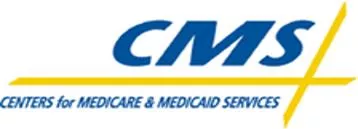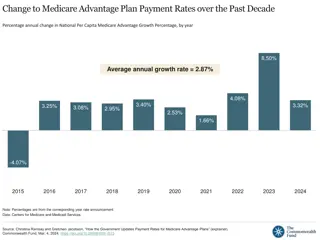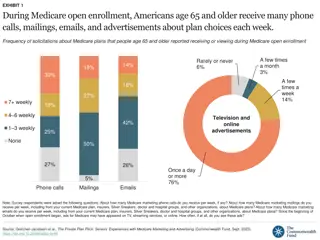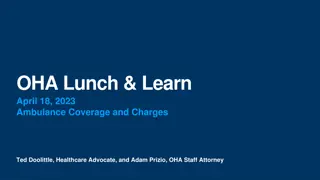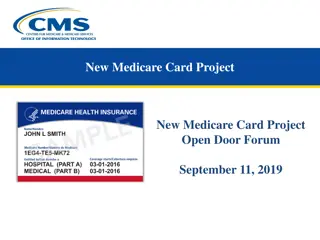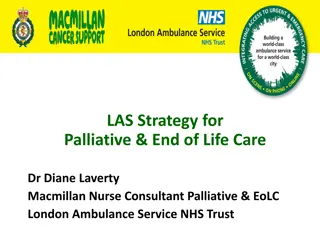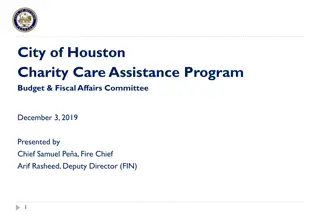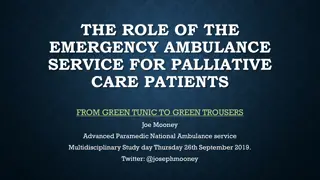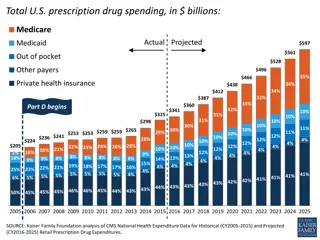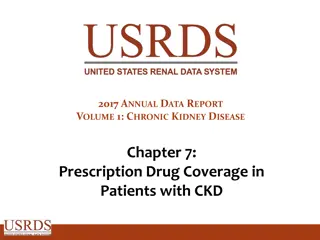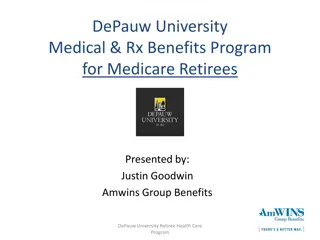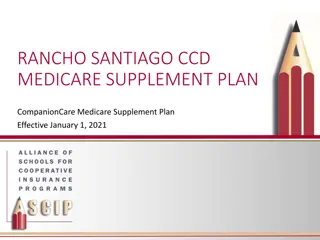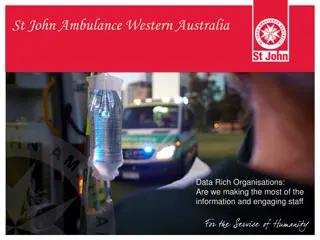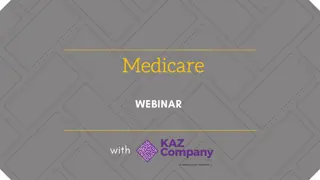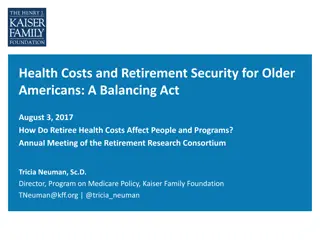Medicare Part B Ambulance Transport Benefit
Medicare Part B covers ground and air ambulance transportation services for Medicare beneficiaries under the Ambulance Fee Schedule (AFS). Learn about the statutory and regulatory requirements, coverage details, and payment guidelines. Find out how Medicare determines payment rates and the responsibilities of beneficiaries for ambulance services.
Download Presentation

Please find below an Image/Link to download the presentation.
The content on the website is provided AS IS for your information and personal use only. It may not be sold, licensed, or shared on other websites without obtaining consent from the author.If you encounter any issues during the download, it is possible that the publisher has removed the file from their server.
You are allowed to download the files provided on this website for personal or commercial use, subject to the condition that they are used lawfully. All files are the property of their respective owners.
The content on the website is provided AS IS for your information and personal use only. It may not be sold, licensed, or shared on other websites without obtaining consent from the author.
E N D
Presentation Transcript
Medicare Part B Ambulance Fee Medicare Part B Ambulance Fee Schedule (AFS) Air Ambulance Transport Schedule (AFS) Air Ambulance Transport Carol Blackford, Group Director, Center for Medicare (CM), Hospital and Ambulatory Payment Group(HAPG) January 15, 2020
Agenda 1. Overview of Ambulance Transport Benefit 2. AFS Statutory Requirements 3. AFS Regulatory Requirements 4. Air Ambulance Transport Coverage 5. Air Ambulance Payment
Overview of Ambulance Transport Benefit Overview of Ambulance Transport Benefit Under the AFS, Medicare Part B covers ground (land and water) and air ambulance transport services furnished to a Medicare beneficiary. Requirements: there is medically necessary transportation of the beneficiary to the nearest appropriate facility that can treat the patient's condition and any other methods of transportation are contraindicated, meaning that traveling to the destination by any other means would endanger the health of the beneficiary. Appropriate destinations include: hospital; critical access hospital (CAH); skilled nursing facility (SNF); beneficiary s home; and dialysis facility for an end stage renal disease (ESRD) patient who requires dialysis. Medicare will pay the base rate and the mileage for a medically necessary ambulance transport to the nearest appropriate facility, and the beneficiary would be responsible for any additional mileage to his or her preferred facility if it is not the nearest.
Overview of Ambulance Transport Benefit Overview of Ambulance Transport Benefit The Medicare payment for an ambulance transport is the lower of the actual billed amount or the AFS amount. Medicare Part B will pay for 80% of the approved amount (1833 (a)(1)(R) of the Social Security Act) with a 20% deductible. Payment rates are available at: https://www.cms.gov/Medicare/Medicare-Fee-for-Service- Payment/AmbulanceFeeSchedule/afspuf Medicare fee-for-service (FFS) program spending for ambulance services in 2017 (not including cost sharing paid by beneficiaries) was $4.6 billion, or about 1 percent of total Medicare FFS spending, and approximately 12 percent of all Medicare FFS beneficiaries used ambulance services. (MedPAC) Medicare covers both air and ground ambulance services with air services representing less than one percent of claims but 8 percent of payments in 2011. (September 2015 Report to Congress) Median payments per air transport increased only slightly between 2010 and 2014 from $6,267 in 2010 to $6,502 in 2014. (July 2017 GAO Report)
AFS Statutory Requirements AFS Statutory Requirements The Social Security Law (the Act) at 1861(s) (7) describes the ambulance services benefit under Medicare as a transportation benefit. The House Ways and Means Committee and Senate Finance Committee Reports that accompanied the 1965 Social Security Amendments suggest that the Congress intended that (1) the ambulance benefit cover transportation services only if other means of transportation are contraindicated by the beneficiary s medical condition, and (2) only ambulance service to local facilities be covered unless necessary services are not available locally, in which case, transportation to the nearest facility furnishing those services is covered. (H.R. Rep. No. 213, 89th Cong., 1st Sess. Rep. No. 404, 89th Cong., 1stSess., Pt I, 43 (1965)). The reports indicate that transportation may also be provided from one hospital to another, to the beneficiary s home and an extended care facility. Section 4531 (b) (2) of the Balanced Budget Act of 1997 added a new section at 1834 (l) of the Act which mandates the establishment of AFS.
Section 1834 (l) of the Act Section 1834 (l) of the Act General: fee schedule for payment whether provided directly by a supplier or provider or under arrangement with a provider through a negotiated rulemaking process. (1834(l)(1) of the Act) Considerations: establish mechanisms to control increases in expenditures, establish definitions which links payment to the type of services provided, consider appropriate regional and operational differences, consider adjustments to payment rates to account for inflation and other relevant factors and phase in the application of the payment rates. (1834(l)(2) of the Act) Savings: ensure aggregate payments do not exceed aggregate payments which would have been made and provide an update based on CPI-U for the 12 month period ending with June of the previous year reduced by the productivity adjustment. (1834(l)(3) of the Act)
Section 1834 (l) of the Act Section 1834 (l) of the Act Services furnished by Critical Access Hospitals: pay 101 percent of reasonable costs. (1834(l)(8) of the Act) 3 Temporary Add-on Payments for ground ambulance: 3 percent increase to the base and mileage rate for ground ambulance transports that originate in rural areas, 2 percent increase to the base and mileage rate for ground ambulance transports that originate in urban areas; and 22.6 percent increase in the base rate for ground ambulance transports that originate in super rural areas. (1834(l)(12 and 13) of the Act)
Regulatory Requirements Regulatory Requirements AFS Proposed Rule: September 12, 2000 (65 FR 55078) and AFS Final Rule: February 27, 2002 (67 FR 9100) established the fee schedule which was the product of a negotiated rulemaking process effective for dates of service on or after April 1, 2002. 42 Code of Federal Regulations (CFR): 410.40 Coverage of Ambulance Services 410.41 Requirements for Ambulance Suppliers 414.601 Purpose 414.605 Definitions 414.610 Basis of Payment formula including level of service, Geographic Adjustment Factor (GAF) and Rural Adjustment Factor (RAF) 414.615 Transition to the Ambulance Fee Schedule
Regulatory Requirements Regulatory Requirements 414.617 Transition from Regional to National Ambulance Fee Schedule 414.620 Publication of the Ambulance Fee Schedule 414.625 Limitation on Review The AFS amount is based on the level of service furnished and includes a base payment, a separate payment for mileage to the nearest appropriate facility and a geographic adjustment factor (GAF). The AFS also incorporates two permanent add-on payments (rural ground and rural air ambulance transports) and three temporary add-on payments (ground ambulance transports) to the base rate and/or mileage rate. The AFS is adjusted annually based on the Ambulance Inflation Factor. Mandatory Assignment ambulance providers and suppliers must accept Medicare allowed charge as payment in full. (42 CFR 414.610 (b))
Air Ambulance Transport Coverage Criteria Air Ambulance Transport Coverage Criteria A medically necessary air ambulance transport must meet the following requirements: The beneficiary s medical condition requires immediate and rapid ambulance transport. The transport of the beneficiary cannot be furnished by Basic Life Support or Advanced Life Support ground ambulance transport because one of the following pose a threat to the beneficiary s survival or seriously endangers his or her health.
Air Ambulance Transport Air Ambulance Transport The medical conditions that may justify air ambulance transport include, but are not limited to, the following (this list is not intended to justify air ambulance transport in all localities): intracranial bleeding that requires neurosurgical intervention; cardiogenic shock; burns that require treatment in a burn center; conditions that require treatment in a Hyperbaric Oxygen Unit; multiple severe injuries; or life-threatening trauma. The transport of a Medicare beneficiary to the nearest appropriate facility, an acute care hospital that is generally equipped to provide the needed hospital or skilled nursing care.
AFS Air Ambulance Payment AFS Air Ambulance Payment The AFS amount is based on the level of services furnished and includes a base payment, a separate payment for mileage to the nearest appropriate facility and a geographic adjustment factor (GAF). Geographic Adjustment Factor (GAF) - non-facility practice expense (PE) of the geographic practice cost index (GPCI) of the Medicare Physician Fee Schedule (PFS); adjusts payment to account for regional differences; is applied to 50 percent of base rate. The AFS GAF is updated annually based on annual updates to the PFS PE GPCI. There are 2 levels of service for air ambulance transports: fixed wing and rotary wing. There is also a permanent add-on payment of 50 percent increase to both the base and mileage rate for rural air ambulance transports. The AFS is adjusted annually based on an Ambulance Inflation Factor (AIF).
AFS Air Ambulance Payment AFS Air Ambulance Payment Base rate for Base rate for Air Ambulance in 2019 Air Ambulance in 2019: : HCPCS Code A0430 Air fixed wing urban: $3,119.83 Air fixed wing rural: $4,679.75 HCPCS Code A0431 Air rotary wing urban: $3,627.27 Air rotary wing rural: $5,440.91
AFS Air Ambulance Mileage Payments AFS Air Ambulance Mileage Payments Mileage for 2019: Mileage for 2019: HCPCS Code A0435 Fixed wing air urban mileage, per statute mile: $8.85 Fixed wing air rural mileage, per statute mile: $13.28 HCPCS code A0436 Rotary wing air urban mileage, per statute mile: $23.62 Rotary wing air rural mileage, per statute mile: $35.43


